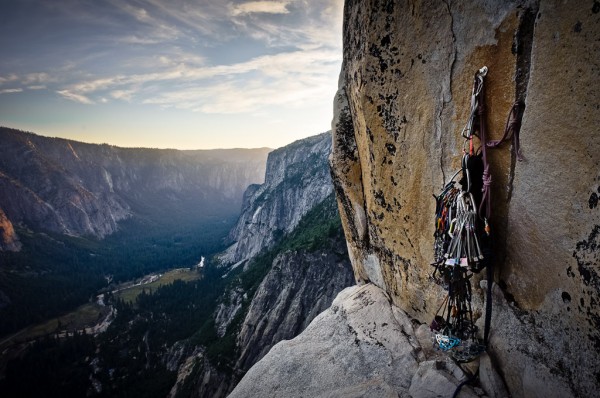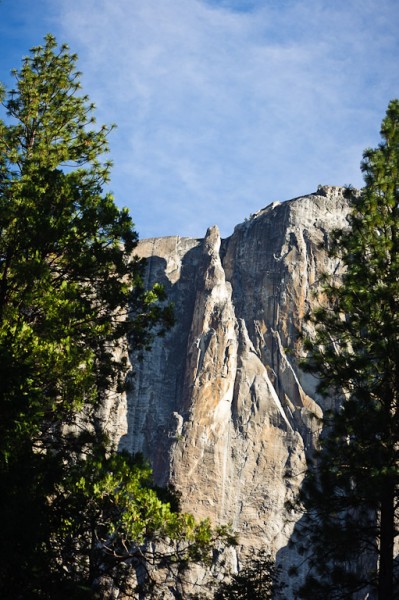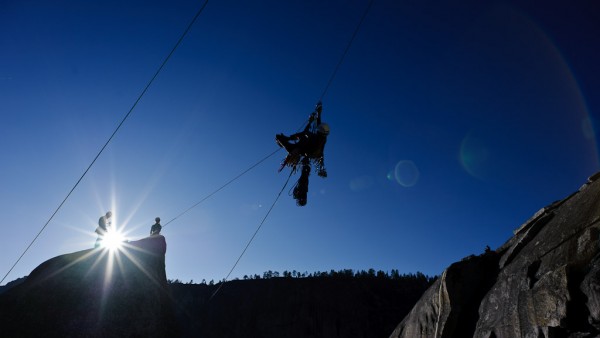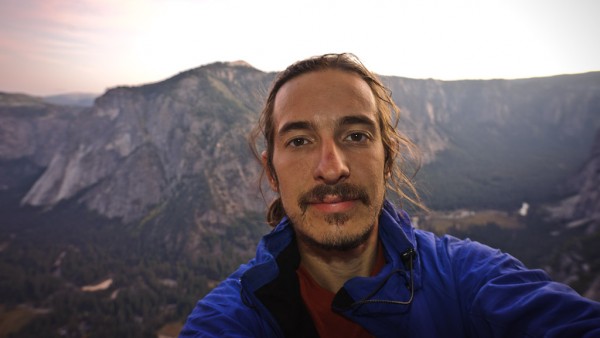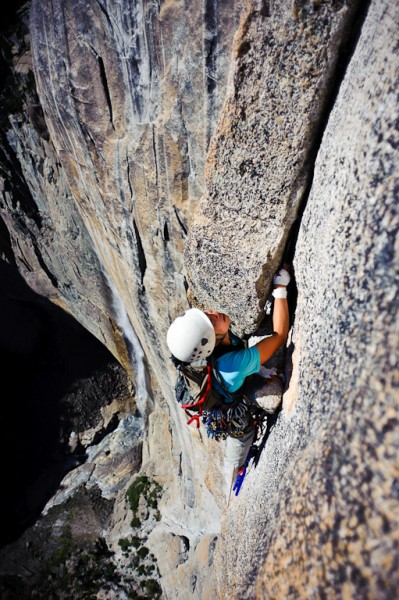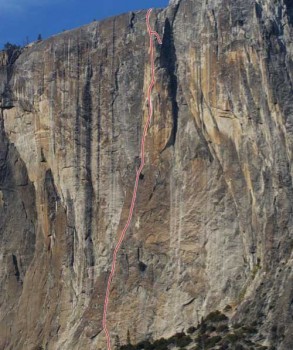In the end, the most surprising fact about this ascent is that everything went exactly according to plan. Considering this was to be my first wall (after incomplete attempts on the South Face of Washington Column and the Nose) and my first time soloing out of the gym, I thought there would be ample room for mistakes and meltdowns on the wall.
I spent four days soloing the awesome route going up the spire next to Yosemite Falls, comprising 15 pitches of mostly aid climbing (the usual grade is V 5.8 C2). I managed exactly four pitches a day, sleeping at the comfy ledges on pitches 4 (First Error), 8 (Second Error) and 12 (just below the Notch) before summitting the spire and meeting Stefan and some other friends who had rappelled from the rim, which permitted to tyrolean across instead of rappelling the whole route.
Things started on Wednesday with a first load of rack and ropes carried to the base, a pretty tough hour and a half on an exposed climber trail, with a big elevation gain and occasional third and fourth class passages. Despite the route not being very popular, I found a party of three Australians at the base, fixing the first two pitches for an early start the next day. Rather than share the ledges with them, I opted to delay my departure by one day and bivy at the base the next evening. Since the seasonal spring had, very unfortunately, dried up, I had to carry all my water, 5.5 gallons (or about 20 liters) up the approach again. I estimated my haulbag to weigh about 30kgs. As I was starting to realize, soloing is hard work more than anything else!
I set up my bivy comfortably a short way from the base, and promptly discovered two facts which would weigh heavily on my ascent: one is that the famed wind which rises every evening and howls, hurricane like, all night long, was far from a myth. The other one was that I had omitted to check the gas level for my stove, and was nearly out. I had to ration it out before the climb had even started, and barely got any sleep that night, a mixture of apprehension of the climb to come, violent winds and fear of receiving a visit from the local wildlife...
The next morning, I waited as long as I could in hopes of the wind dying down before getting up in the cold. A quick breakfast and a gear check later, there was no more procrastination possible: I had to get started. I racked up, built a good belay on the ground, set up my soloing device (the Silent Partner), double checked, triple checked and quadruple checked, then started up the short 5.7 first pitch. In signs of the climb to come, my first piece was the giant #6 camalot, and my second the barely less giant #5, cams I had only placed a handful of times ever before. The pitch was easy enough, with decent holds that kept appearing in the blankest sections. Soon I was at the belay, discovering the true crux of solo climbing: you have to do it all yourself, and be extremely tidy at the belays. After each pitch, I had to rap down to the previous belay, cleaning my gear on the way, release the haulbag, clean the belay, jug back up, haul, then restack the ropes before finally being allowed to continue climbing.
The second pitch started with a bolt ladder, and I switched to full aid, more or less never going back to free climbing. The aid went smoothly enough, as I had accumulated enough pitches of training with Sweden last summer and both half walls of the previous week. A bit too soon to my taste, however, I was at the next belay and looking at the task at hand: the offwidth/chimney third pitch. Setting the tone, it took me a good five minutes to even manage to get off the ground. Desperately bad at offwidth (but then who isn't?), I relied on shoving very big cams deep into the crack, then pulling, kicking and shoving on my aiders, raising a few meager centimeters, then realizing the crack had widened a bit and needed even bigger cams. After swimming upward for a third of the pitch, I had reached the limits of my biggest cam and big bro, having used them completely tipped out on the last couple of placements (it's scary but it works!). I was also getting a healthy runout, as I kept walking the cams up instead of leaving them down for pro. A couple of meters up, I could see a side crack with lovely #1 and #2 camalot placements, but no way to get there. Finally, in an act of total desperation, I did the unthinkable and started free climbing the monster crack, which had almost become a squeeze chimney at that point. Sweating, sliding and swearing, I struggled desperately upward until I finally reached my lifeline of a reasonably sized crack. The rock was rotten but I was way past caring about that, and aided vigorously to a bolt, then to another wide section, before, at long last, reaching the belay. It turned out I had only spent an hour and a half, though I commented aloud that it had felt like a lifetime and a half.
At this stage, the afternoon was well under way, I was utterly exhausted and still had a pitch before hitting the first bivy ledge. The topo said "5.9 awkward", and awkward it was, though at least the cracks were of a more reasonable size this time around. Half an hour before sunset, I had led, cleaned and hauled the pitch, and my first day was over. My plans of fixing one or two extra pitches were definitely out of the equation, though, as climbing those four rope lengths had taken so much from me. I hurried to cook dinner before the wind made using a stove impossible then collapsed into my bivy bag, falling asleep shortly after 8pm.
Getting out of my sleeping bag in the cold wind of the morning was a serious challenge, but after an hour, I was back on the rock. The first pitch was quite fun aid climbing and included a long pendulum into a rotten gulley. I initially feared cleaning would prove complex and time consuming before realizing one of the few advantages of solo climbing: since you usually clean on the way down, traverses and pendulums are no big problem and jugging back up straightforward.
The next two pitches took me most of the day but were amazing: endless thin, pin scarred cracks up a beautiful face. Both pitches logged over 40m each, and I went down into a semi-trance, focused entirely on the next placement, the next piece of gear, the next meter of rock. I was entirely on my own schedule, doing my own thing, and during those few hours more than at any other point, I found what I had been looking for when I decided to solo the wall.
The last short pitch before the second ledge only said 5.5 chimney to 5.5 face, which would have seemed to indicate a very easy passage. As I was to discover, it mostly meant rotten rock and difficult transitions from aid to mandatory free climbing. I was also to realize that chimneying with a full aid rack and a small backpack is far from easy. The transition from chimney to face involved an out of balance move off a ''very'' loose flake which held my only piece of gear in the previous couple of meters. Last shot of adrenaline for the day, though not the end of the swearing as my poop tube, hanging below the haulbag got caught in a crevice and required yet another abseil down the pitch to fix.
I was now up pitch 8, more than halfway on the route and spending the night on one of the coolest ledge I have ever seen, a roomy 3x3 meters, detached from the main wall and dropping directly a couple of hundred meters down from the edges! The wind was late to arrive that night, which allowed me to get some much needed rest before it started waking me up every hour or so.
The next day was the pivotal moment. I was physically exhausted and had all the aid cruxes in the next four pitches, which would improve the scariness of the climbing. More importantly, I was starting to break down mentally. The climb was so much hard work, with literally not a minute of break time from sunrise to sunset that I starting to feel like I had been too ambitious. Many times during the day, I surprised myself looking for excuses to go down: my hands were ruined (true), a split fingernail was threatening to come off, which would make my right hand unusable (it didn't), I had run out of gas (not quite, and beside I had enough cold food left), I didn't have enough water (I had just enough), the aid was too hard for my skills or my gear (it wasn't, though not by much)... In the end, I just kept going, perhaps simply because rapping down would be more complicated than just keeping on. Or perhaps because another reason I wanted to solo was to test myself, and something deep down in me wanted to pass.
Though the first pitch off the ledge was a mellow bolt ladder, it caught me cold with the hardest move of the route: stepping off a rivet into a very slopping ledge, at the edge of the friction ability of my shoes, with no hands to stabilize myself and no gear to yard on. Desperately out of balance, I tried for a good ten minutes, always retreating moments before pitching off in what would be my first fall. I tried all my aid climbing paraphernalia on the few features before managing to set a wobbly hook in some dirt at the very edge of my full extension, my left foot a couple of centimeters off the rivet, my left hand pulling hard on it trying to stabilize myself with my body almost completely horizontal. The hook looked terrible but I had run out of options. Using my patented method of the beached whale, I swam upward on the slope, using as much friction from my full body. I felt myself starting to fall off when my weight came off the rivet but I pulled hard on the hook and, surprisingly, it held. Terrified, I reached up and put no less than three cams in the crack above before finally trusting myself to stand up. And that was supposed to be the easy pitch of the day!
The topo was indeed misleading. The next section, supposedly C2, was dead easy with offset cams (I used them so often I started addressing them directly...) but halfway up the pitch, I was stopped dead in my tracks. A three meters section was completely blank and the only option a thin crack way off to the side. Standing on two fixed RURPs (pitons the size of a big thumb nail), I tried all my gear blindly on the crack. At some point, the yellow/blue offset looked like it would hold and I gingerly transfered my weight on it before it suddenly blew off and I swung back to my original position. Lacking alternatives, I positioned an upside down cam hook resting on about a quarter of its length and moved my weight on it. I wasn't any higher but at least I was in the plumb line of the crack. I played with the yellow/blue offset again, with predictably similar results before settling on a medium beak with some camming action, touching the rock only with a couple of millimeters on its tip. I moved up on it. It held. 30 centimeters gained. Another upside cam hook almost felt bomber. Then the edge of the crack went almost horizontal and I managed to place a wobbly skyhook. Finally, by reaching as high as I could, I managed to put the yellow/blue (again) in a good piton scar. Aid crux complete, I felt like I had leveled up as a true aid climber!
The next two pitches were comparatively easy, if very long and somewhat awkward. The final pitch of the day was supposed to be the crux of the day, with some C2+ climbing, but a combination of much fixed gear and offset cams made it a C1 breeze, only marred by blowing two different placements and having to perform some emergency landings on previous pieces...
I reached the bivy ledge, 80 feet of 5.6 climbing down from the notch between the spire and the rim. Only three pitches left before the summit, and for the first time I really allowed myself to believe I might succeed. The dinner, disgusting as only dehydrated creamy parmesan sauce mixed with remains of the three precedent dinners can be, felt delicious.
I awoke to a tough morning. I expected the 5.6 pitch to be easy scrambling to the notch, a mere formality before the two aid pitches of the tip. Instead, what I got was exposed and sketchy free climbing in approach shoes and very rotten rock. There were many different options but after exploring all of them, it seemed all involved chimneys and offwidths. Helped by a copious amount of swearing, I started up the least intimidating of them, in the worst rock of the route yet. Upon loading, each cam would slide a few centimeters before stabilizing in the crud.
When I reached the notch, at around 10am, I started despairing: there still wasn't anybody rappelling from the rim. If no one showed up with a rope anchored on the cliff, I couldn't do the Tyrolean and would have to rappel the whole route, a long and scary perspective. Turning these thoughts off, I focused on the climbing at hand, some of the best ones of the route, though it got off to a bad start: I placed an offset cam in the first crack, said aloud "Wow, this is 100% bomber" then blew the placement three seconds later, injuring a finger in the process. Lesson learned, I proceeded with more caution and reserved judgment about my placements until ''after'' I had loaded them! The last bit of wide climbing was overcome with the help of my trusty #5 and #6 and I was soon at the Salathe ledge. While cleaning the pitch, I saw the most beautiful thing ever: a rope thrown over from the rim. In a split second, the overlook of my day switched from grim rappels to a fun Tyrolean traverse and a stroll back to camp on a hiker's trail.
The second surprise happened a few minutes later when I realized who was rappelling: Stefan, my partner up the Nose and Washington Column, who had switched to free climbing in the past few days! Accompanied by Enmore, an Australian girl, they had picked the right day to go do the Spire Tip route. I headed back up my pitch to finish the route solo while they worked their way up the first pitch. Unrelenting, the route kept me on my toes until the very end. A bolt ladder, then a sideway hook move, more bolts, a C1 crack and some fixed pitons before accessing the final reachy ladder. Then a few bolts up the final slabs. A transition to friction climbing where I almost lost my footing. Three more steps and I clipped one of the many belay bolts.
Somehow, I was on top of Lost Arrow Spire. I sat down and generously gave myself a few minutes of break before heading back down to clean and haul.
The rest of the day was fun and laid back, especially after Andrew, a Scotsman who had bailed with us from the Nose showed up, having run the trail with two ropes just to set up the Tyrolean for me! I abseiled down numerous times to take photos of Enmore leading the last pitch and people doing the crazy exposed (and exhausting) Tyrolean traverse. When everybody had crossed, just as night was falling, we all headed back down the endless trail to promises of beer and food.
I'm still not sure why or how, but I have now completed my first wall and my first solo. And it feels great.
